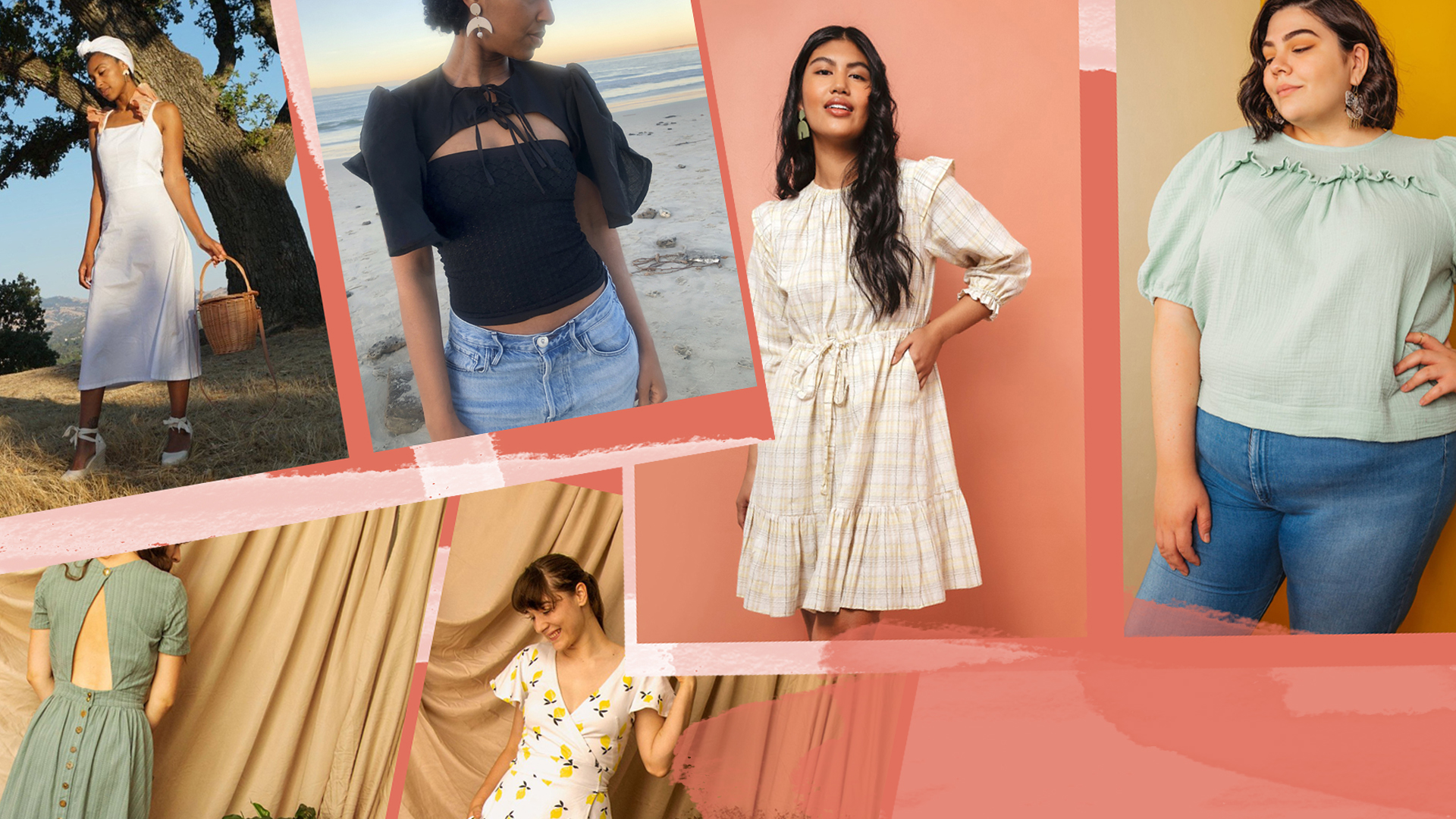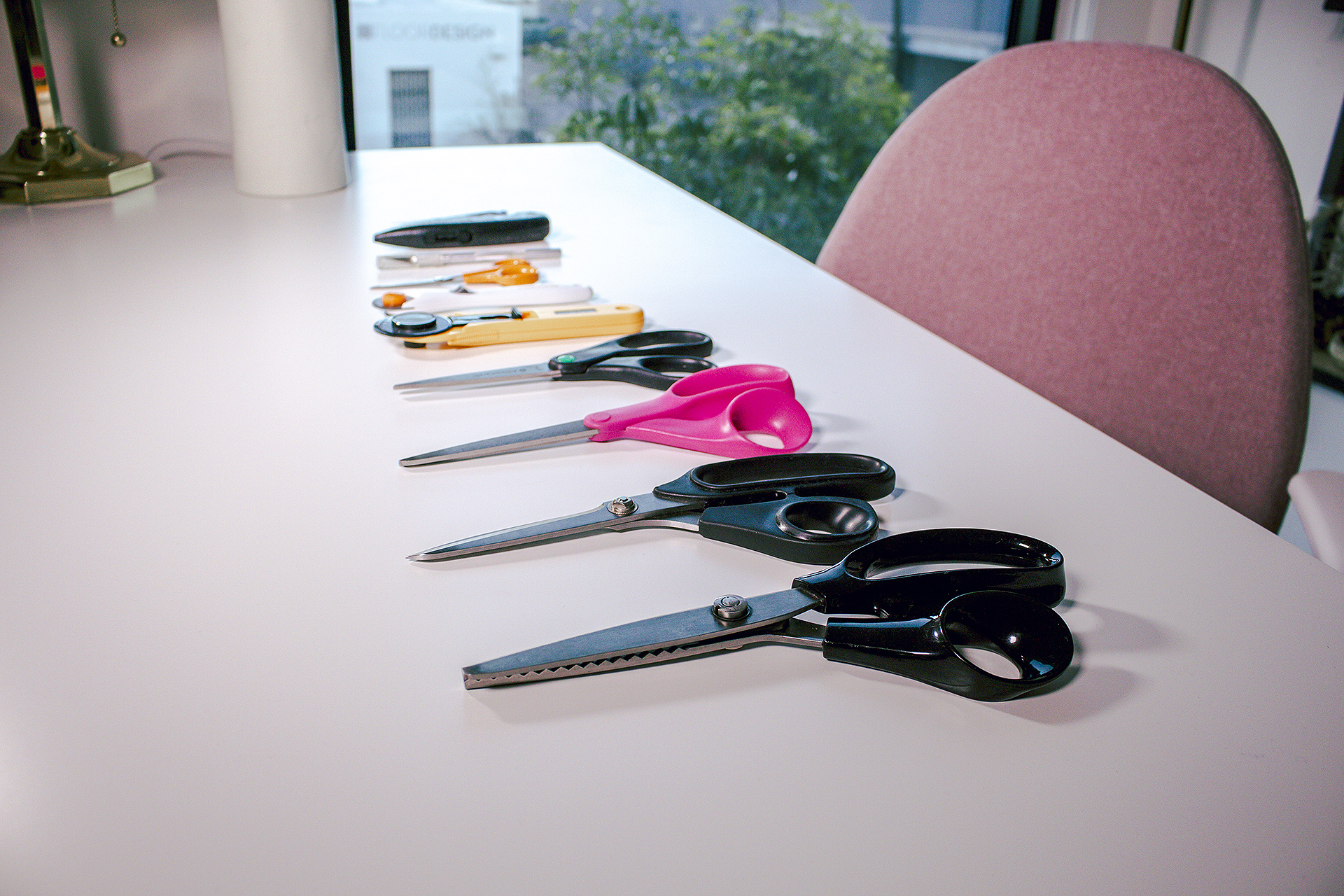
There are many memes on the internet regarding sewing and fabric buying.

To be honest, if you’re brand new to sewing, they can be really misleading. The fabric world can be your oyster– or it can be overwhelming and cause anxiety trying to figure out the perfect apparel fabric for that blouse you want to make.
Let’s be real: walking into a fabric store can be a mind blowing experience.
What fabric do you chose? How do you know what fabric works for what garment? And if you’re buying fabric online… where do you even start?
The topic, unfortunately, is usually glossed over on most sewing blogs and websites, and while it may seem super 101 and basic, it doesn’t get discussed enough. Your entire sewing project is impacted by the fabric you choose.
Before I dive into this topic…
Picking fabric for clothes is a personal choice. Please, 100% feel free to use whatever fabric you want to use. Netting and tulle for dresses? Sparkly jacquard for a pair of trousers? Jersey for a bathing suit? Part of the sewing experience is experimenting, playing with materials, and having the freedom to do whatever you envision.
With the above disclaimer, my fabric point of view is highly informed by university study. Mainly:
I don’t want my home sewn garments to look homemade. I strive to make sure that my garments look professional, “unclockable”, and as RTW as possible (even if I sew vintage fashion!) When I walk down the street, I don’t want a single person to realize that the garment I’m wearing was made on a home sewing machine.
While in university, my teachers without hesitation would point out what was obviously homemade… “Oh. That looks very home sewing.”
As someone who started university with previous sewing experience, that’s not such a positive thing to hear, especially when using pricier fabrics is sometimes out of reach. However:
The top way to make your home sewing look and behave professionally is to chose the best fabric for dressmaking at your price point.
Below are my tips for how to approach picking fabric for sewing, based on my years of sewing experience.

Carefully review the suggested fabrics on the back of your sewing pattern.
The list can be long, confusing to look at, and if you’re new to sewing, be just too much. Especially when the section is usually titled, “Suggested and Recommended Fabrics.”
Before tying yourself in knots picking fabric, take the time to consider the following question:
What is the purpose of the garment you want to sew? Is it for work? For fun? Date night? Holiday party?
Breaking down the reason you want to sew something will help narrow down the long list of fabrics on the back of the pattern.
If you’re sewing something for a traditional work setting, you may want the fabric to look and feel crisp, to maintain a specific shape and feel that is work appropriate. Maybe you want the fabric to not attract cat hair that sticks to your clothing before heading into an important meeting.
If you’re sewing something for fun, what sort of fun are you thinking? Saturday-evening-board-game sort of fun? Playing-soccer-with-friends sort of fun? If you’re looking for lounge clothes for Saturday evening board games, you might want something you can be comfortably curled into on the couch playing Monopoly. If you’re planning on playing soccer in your me made clothing, you may want fabric that is sweat-wicking and won’t cling when it has grass stains.
The suggested fabrics may be extremely different, but it’s important to remember the list is what the pattern designer suggests, based off the way the pattern designer intended the garment to be worn. There are dozens of unlisted fabrics that may be used for nearly every single pattern.
When in doubt: what are the fabric properties you want you garment to have?

Check your swatch book before looking at what’s currently available in your local stores or online.
Having a robust and thorough swatch book is key at this stage, especially if the range of recommended fabrics or fabric qualities you’re interested in is pretty large. Pulling out your swatch book to compare is imperative!
Don’t have a swatch book? Now is the time to set yours up:

What is a swatch book?
A collection of swatches which are organized in a reference binder. The swatch pages list fabric names, fiber content, fabric qualities, and even where you sourced each swatch in your collection!
Taking five or ten minutes comparing the samples you have in a swatch book against a sewing pattern’s recommended fabrics will save you time, money, and headaches down the road by picking exactly the right apparel fabric.
To continue with the above examples:
If you’re looking at making something for the office, you may find that half of the recommended fabrics on your sewing pattern will be too thin, too flimsy, and may not fit into the qualities you’re looking for at your traditional workplace.
If you’re making a sweatshirt for lounging at home on game night, part of your sewing pattern fabrics may be too stiff and won’t lend themselves to being comfy on the couch.
And for your soccer gear, the recommended fabrics might be too athleisure and less performance and may not hold up during a rough game.
Likewise, after reviewing all the recommended fabrics, you might find that you have other fabric types in your book which are better suited for your handmade garment and possess enough similar qualities to the the fabrics listed on the back of the pattern and could work!
The key to having a robust swatch collection for this review, though, is to make sure to continue to build your swatch book over time.
Using services such as Mood Fabric’s recently started Mood Swatch Club will help build your book quickly, and immediately give you access to swatches to start picking fabric for your clothes.

I recently received a free sample box of the Mood Swatch Club, and was immediately impressed by twenty-five beautiful sample swatches that I immediately added to my swatch collection. It was also super handy that each fabric swatch came with sticker on the back with fabric details, including fabric number to view on Mood Fabric’s website for more information

When you expose yourself to as many different fabrics as possible, you’re able to identify and spend time picking fabric for your sewing with ease and confidence.

Go to fabric stores (online or in person) with a plan.
The best comparison for this point is think of grocery shopping. There’s three different camps of people:
Person Number One: The people who shop with a grocery list. They decided ahead of time what they needed, they have a list on their phone or on the back of an envelope, and they’re in and out. If they see a pint of ice cream or something they like last minute, it’s all good to throw it in the cart, because they didn’t miss the important stuff.
Person Number Two: The people who shop without a grocery list. They tend to shop last minute, have a vague idea of what they need, and because they didn’t preplan, tend to circle the store a lot more for what they need. Shopping easily takes two or three times as long as the person with a list and they may not remember things they needed since it wasn’t top of mind.
And bonus…
Person Number Three: The people who shop hungry. They tend to go in in a hurry, may be HANGRY and make purchasing decisions they tend to regret. They may also forget things they needed while they were rushing out to go make dinner or pick up take out.
My best sewing advice for fabric selection is… be Person Number One. Setting foot into a fabric store without a plan of action leads to the above sort of behaviors without looking out for the fabric you really need for your garment.
Before I dive into this point…
I’m all for browsing the fabric stores and enjoying the act of browsing. If anything, it’s a decompressing hour or two that I actually look forward to and savor. But if I’m on a sewing mission, I’m on a mission!
Person Number One does some (or all) of these things:
- Brings a pattern envelope, photocopy, or photo on their phone of what they want to make, so they can envision the fabric they’re looking at in store (or online) on their intended garment.
- Brings a swatch or two from their swatch book to compare to what’s available.
- Knows ahead of time what notions (sewing needles, thread, etc.) they’re going to need for the fabric they’re looking for.
While in store, going in with a vision of what you want– look, feel, color, all of that– will help narrow down what you’re on the hunt for. This does NOT mean closing yourself off to inspiration (remember: Person Number One goes for the ice cream pint if they want it!) It does, however, mean that if you’re deviating from your intended fabric qualities, you’re making a conscious decision to do so and are better equipped to understand how that’ll affect your garment.

Other Fabric Picking Considerations
Pick the best fabric you can for your price point. Without diving into have-and-have not conversations, having honest self assessments as to what range of fabrics can be reasonably purchased is 100% important to success.
Don’t buy the $100 p/yard fabric just because. Also, don’t buy the $2 p/yard fabric just because, either.
Look for the qualities and feel you want and then decide from there what is best for your garment. A giant SALE sign does not automatically equate to the dress or blouse you want to sew. Likewise, taking a peek at the sales rack didn’t hurt anyone.
I’ve found some of my favorite fabrics on the sales racks, such as with this tana lawn fabric I used to make a tie top and matching skirt.

But I’m also not shy about spending that little bit extra if the fabric behaves exactly how I want.
Also, not all versions of a single fabric are the same. Depending on manufacturer, fabric store, or even country of origin, fabrics with the same name will vary. Also, fabrics may be mislabeled or be called different names depending on the store.
Having your ideal swatch type in hand when you go fabric shopping will help guide towards the right selection that’s right for you. If you’re buying online, order a swatch of what you believe is going to be the best fabric to use and make your decision after that point.
Have any other tips for selecting fabric for dressmaking? Leave your tips in the comments!

Thanks again to Mood Fabrics for the Mood Swatch Club sample! I loved receiving it and the fabric samples were fantastic. I highly recommend it, everyone! Mood Fabrics took a lot of care in how they put their box together and I really loved how the whole thing was packaged and shipped. It was legitimately (full personal opinion here!) one of those sewing treats to receive. I actually was super excited to open the box and pour over every fabric sample. Whomever is deciding on these swatch samples on the Mood Fabrics team… wow- you’re knocking it out of the park!
If you sign up for the Swatch Club, be sure to tag me on Instagram (@vintageontap) to see what you thought of your box! I hope you love it as much as I did!





























